Financial markets have been extremely volatile in the last couple of weeks, as all of a sudden, investors realized central bank officials still have the ability to surprise them.
After years of inaction, the Bank of Japan (BoJ) hiked interest rates by 15 basis points (bps), and Governor Kazuo Ueda delivered a hawkish speech in which he mentioned that interest rates were still “low.” The Japanese Yen (JPY) soared with the news and put the US Dollar under selling pressure, as the American currency was already struggling following a batch of weak macroeconomic figures that spurred concerns about growth in the world’s largest economy.
Nevertheless, the United States (US) economy kept proving resilient, and concerns faded. Back and forth in rate cut bets seem to have stabilized, and investors are looking for a first Federal Reserve (Fed) interest rate cut in September. As a result, the US Dollar spent most of August on the back foot, with the BoJ kick-starting the USD decline, but it is far from being the only one responsible.
Focus shifts from inflation to employment
The focus has been so long on inflation that sometimes speculative interest forgets that most central banks have dual mandates. Stable employment is the second leg in which the Fed’s mandate rests, and it has returned to the spotlight.
As Fed officials won confidence in the inflation rate returning to 2% – although clarifying that they are not still there – unemployment levels gained relevance. The latest Nonfarm Payrolls (NFP) report showed the Unemployment Rate rose to 4.3% in July, still below the long-run average of 5.7% but higher than the 3.7% low posted in January.
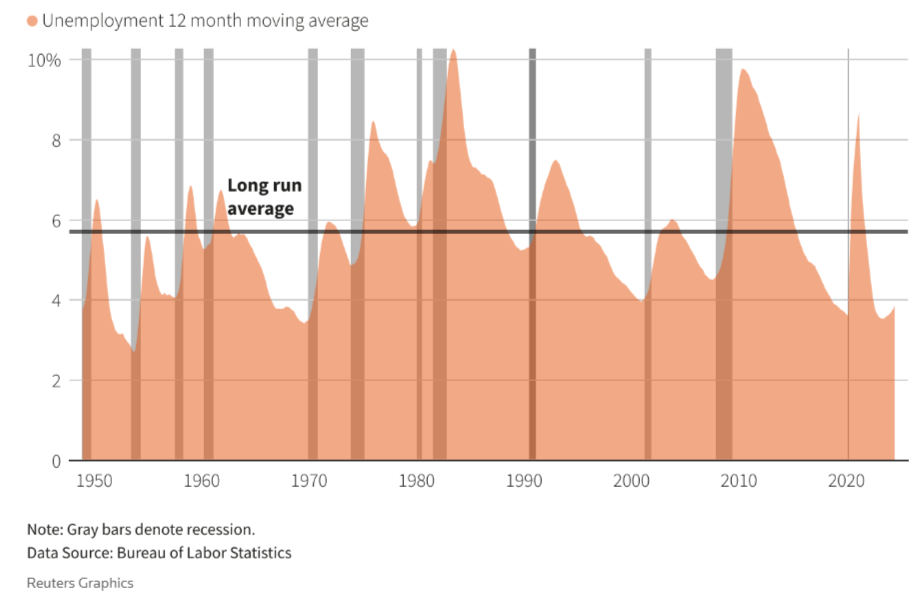
Chairman Jerome Powell and co had long ago explained that a low unemployment rate poised a risk to inflation, as high labor demand increases manpower costs. But the US economy has come to a point in which the labor market is no longer tight, while inflationary pressures continue to recede.
The Fed statement from the July meeting included a critical change in the wording, as policymakers now believe “job gains have moderated” from the previous “have remained strong.” Officials also remarked that the unemployment rate “has moved up” but added that it remains low. It’s worth clarifying that when the meeting took place, the latest official unemployment figure stood at 4.1%.
Policymakers pave the way for a September cut
In the press conference that followed the latest Fed’s decision, Powell said a rate cut in September is “on the table” and added that recent data suggest a “normalizing labor market.” His shifts towards a more dovish stance encouraged investors to bet on a 50-basis-points (bps) interest-rate cut in September, despite Powell saying it is quite unlikely.
At the time being, odds for a 50 bps rate cut stand at 32.5%, while 67.5% foresee a 25 bps trim, according to the CME FedWatch Tool.
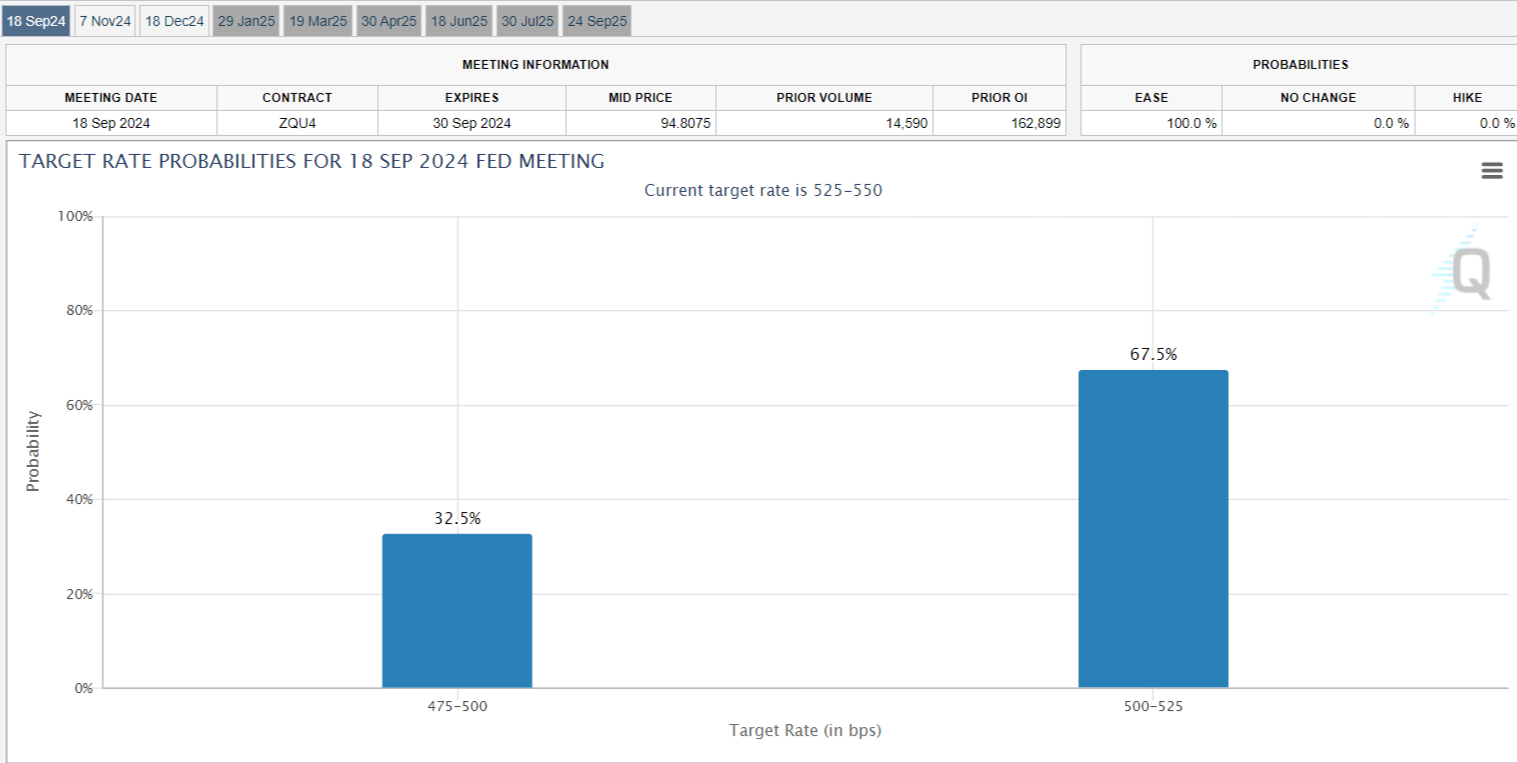
But Powell was not alone. President of the Federal Reserve Bank of Atlanta Raphael Bostic said he is open to an interest rate cut in September as the US central bank can’t “afford to be late” to ease monetary policy amid signs of cooling in the labour market. Also, the well-known hawk, Minneapolis Fed President Neel Kashkari, said that the balance of risk has shifted, adding that “the debate about potentially cutting rates in September is an appropriate one to have.”
At this point, it seems there won’t be any surprises from the Fed when it meets next month. But is that so?
Fears of a potential recession have fueled speculation for a loosen monetary policy. However, as said before, the US economy has proved resilient.
The US Gross Domestic Product (GDP) expanded at an annual rate of 2.8% in the second quarter of the year, according to preliminary estimates from the US Bureau of Economic Analysis. The reading followed the 1.4% growth recorded in the first quarter and came in above the market expectation of 2%.
The accompanying report showed that “The increase in real GDP primarily reflected increases in consumer spending, private inventory investment, and nonresidential fixed investment. Imports, which are a subtraction in the calculation of GDP, increased.”
Beyond relatively healthy growth, the unemployment level is below average, while inflation is barely above the central bank’s goal.
The case for a rate cut in September is not as solid as investors believe. There are more chances that Fed officials choose to trim rates to catch up with its pairs than because of the economic situation, as at this point, most major central banks have already proceeded with interest-rate cuts.
US Dollar Forecast and Potential Scenarios
Generally speaking, economic progress results in a stronger currency. Yet interest rate cuts tend to have the opposite effect, weakening the currency. But even if the Fed delivers, fireworks may be missing.
Market players have already priced in a rate cut. The only “uncertainty” is if it will be by 50 or 25 bps. Should the Fed refrain from touching interest rates, the Dollar would likely soar, while a 50 bps cut could have the opposite result. A 25 bps cut could spur some intraday action but will not be a game-changer.
The US Dollar Index trades at its lowest since early January, just above 101.31, the year low posted in August. A slide towards the 100.00 threshold seems likely as expectations of a rate cut mount, while a break below the level will confirm a longer-term bearish trend. A recovery of the index will depend on whether it’s able to regain the 102.00 mark, with the scope then to test 103.15.
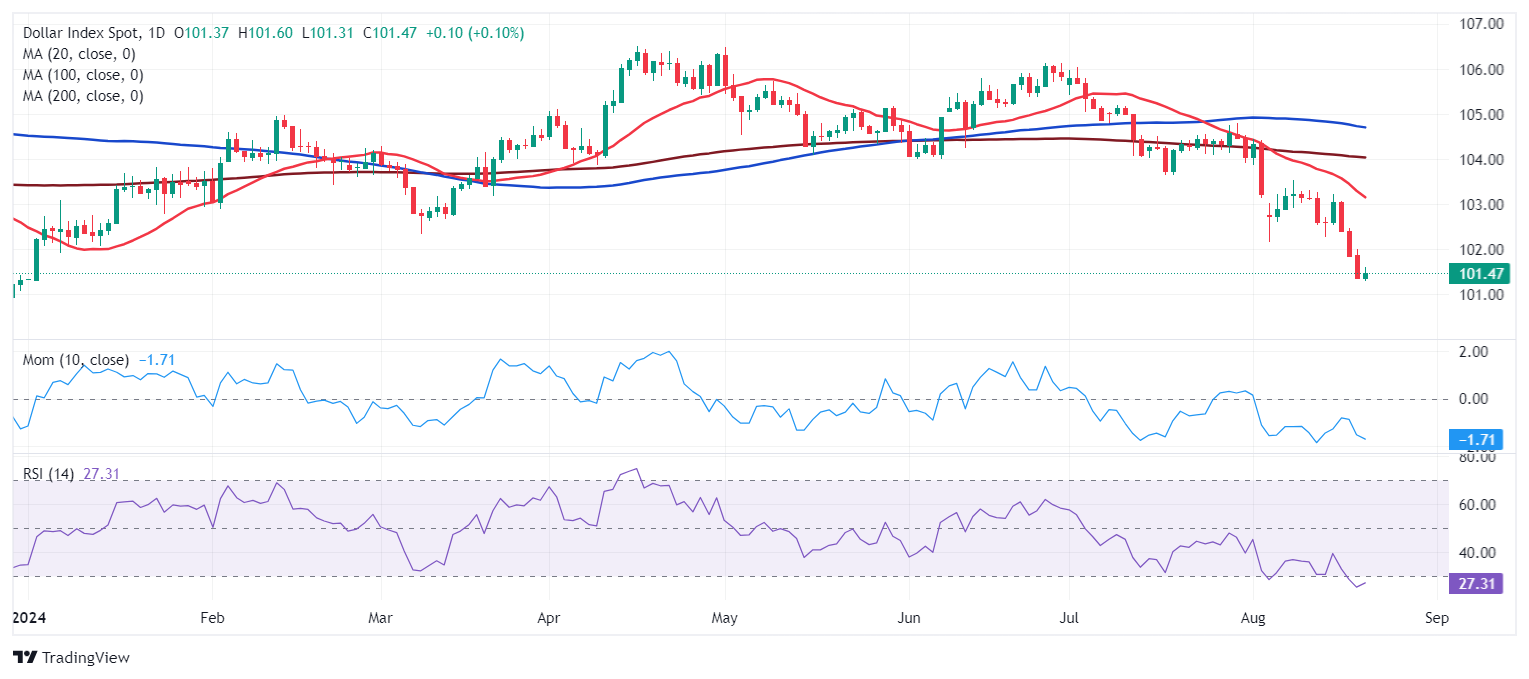
Economic Indicator
Fed Interest Rate Decision
The Federal Reserve (Fed) deliberates on monetary policy and makes a decision on interest rates at eight pre-scheduled meetings per year. It has two mandates: to keep inflation at 2%, and to maintain full employment. Its main tool for achieving this is by setting interest rates – both at which it lends to banks and banks lend to each other. If it decides to hike rates, the US Dollar (USD) tends to strengthen as it attracts more foreign capital inflows. If it cuts rates, it tends to weaken the USD as capital drains out to countries offering higher returns. If rates are left unchanged, attention turns to the tone of the Federal Open Market Committee (FOMC) statement, and whether it is hawkish (expectant of higher future interest rates), or dovish (expectant of lower future rates).
Read more.Next release: Wed Sep 18, 2024 18:00
Frequency: Irregular
Consensus: -
Previous: 5.5%
Source: Federal Reserve
Information on these pages contains forward-looking statements that involve risks and uncertainties. Markets and instruments profiled on this page are for informational purposes only and should not in any way come across as a recommendation to buy or sell in these assets. You should do your own thorough research before making any investment decisions. FXStreet does not in any way guarantee that this information is free from mistakes, errors, or material misstatements. It also does not guarantee that this information is of a timely nature. Investing in Open Markets involves a great deal of risk, including the loss of all or a portion of your investment, as well as emotional distress. All risks, losses and costs associated with investing, including total loss of principal, are your responsibility. The views and opinions expressed in this article are those of the authors and do not necessarily reflect the official policy or position of FXStreet nor its advertisers. The author will not be held responsible for information that is found at the end of links posted on this page.
If not otherwise explicitly mentioned in the body of the article, at the time of writing, the author has no position in any stock mentioned in this article and no business relationship with any company mentioned. The author has not received compensation for writing this article, other than from FXStreet.
FXStreet and the author do not provide personalized recommendations. The author makes no representations as to the accuracy, completeness, or suitability of this information. FXStreet and the author will not be liable for any errors, omissions or any losses, injuries or damages arising from this information and its display or use. Errors and omissions excepted.
The author and FXStreet are not registered investment advisors and nothing in this article is intended to be investment advice.
Recommended Content
Editors’ Picks

AUD/USD edges higher to 0.6000; bulls lack conviction amid US-China trade war concerns
AUD/USD holds above its lowest level since March 2020 touched the previous day and trades with a positive bias around the 0.6000 mark during the Asian session on Tuesday. A stable performance around the equity markets, following the previous day's tariffs-inspired volatile swings, support the risk-sensitive Aussie amid subdued USD price action.
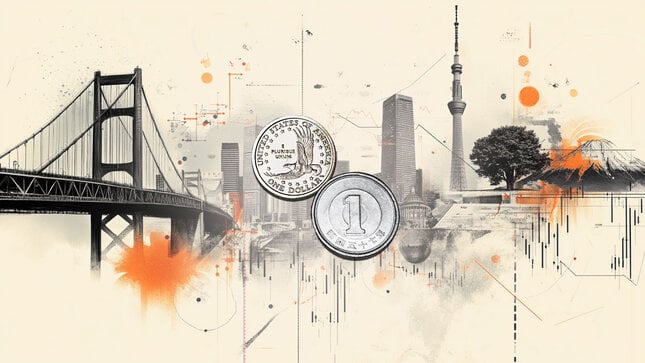
USD/JPY stalls its recovery from multi-month low; remains below 148.00
USD/JPY oscillates around the 148.00 mark during the Asian session on Tuesday amid mixed cues. A modest recovery in the global risk sentiment, along with receding bets that the BoJ would raise the policy rate at a faster pace, undermines the safe-haven JPY.

Gold price moves away from multi-week low; looks to reclaim $3,000
Gold price edges higher during the Asian session on Tuesday and now seems to have snapped a three-day losing streak to a nearly four-week low touched the previous day. Concerns that a trade war will hit the US economy and trigger a recession, along with mounting bets for more aggressive rate cuts by the Fed, cap the USD recovery.
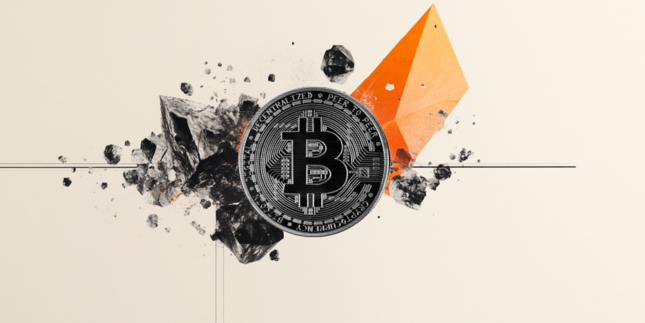
Trump tariffs shake crypto markets, where are Bitcoin and meme coins headed?
Bitcoin and altcoin prices were on a rollercoaster ride on Monday as traders digested the developments surrounding tariffs. From speculation of a 90-day pause on tariffs to Bitcoin’s price swinging from a $74,500 low to $81,200 high within a single day, the crypto market meltdown has been an event for traders.

Strategic implications of “Liberation Day”
Liberation Day in the United States came with extremely protectionist and inward-looking tariff policy aimed at just about all U.S. trading partners. In this report, we outline some of the more strategic implications of Liberation Day and developments we will be paying close attention to going forward.

The Best brokers to trade EUR/USD
SPONSORED Discover the top brokers for trading EUR/USD in 2025. Our list features brokers with competitive spreads, fast execution, and powerful platforms. Whether you're a beginner or an expert, find the right partner to navigate the dynamic Forex market.